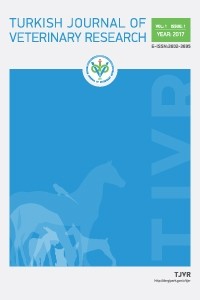The Evaluation of Arterial Blood Pressure in Anesthetized Dogs with Xylazine and Ketamine
The Evaluation of Arterial Blood Pressure in Anesthetized Dogs with Xylazine and Ketamine
Objective: It was aimed to investigate the effects of ketamine combination administered with xylazine used for general anesthesia in dogs on arterial blood pressure, heart rate, and body temperature.Materials and Methods: In the study, a total of 20 dogs, 14 females and 6 males, from various breeds and ages 1 to 5, which undergone elective ovariohysterectomy or castration according to body weights. 1 mg/kg xylazine (xylazine hydrochloride, 23.3mg/ml, Xylazinbio 2% Bioveta®, Czechia) and 10 mg/kg ketamine (ketamine hydrochloride, 100 mg/ml, Ketasol 10% Richter® Pharma Ag, Austria) combination within a single injection with 21G needle were applied intramuscularly. The food and water access were ceased 12 hours before drug administration. Systolic and diastolic blood pressures, pulse measurements, and body temperatures were measured 3 times before and 5 times during anesthesia (at the 15th, 30th, 45th, 60th and 120th minutes of anesthesia) by using the AM6100 veterinary bedside monitör. Muff was placed to cover 1/3 of the proximal leg and for the artery to be recognizable by the microprocessor. Pulse rates were measured with electrodes connected to the device. Body temperature was measured by a rectal thermometer which was a part of the device. Measurements were taken before anesthesia was considered as control measurements.Results: In systolic blood pressure, the recordings at 0, 15th, 30th mins have been found as statistically significant in relation to 45th, 60th, and 120th (p<0.05). In diastolic blood pressure, there were no significant differences recorded. The change between the preintervention and post-application has been found significant (p<0.001). Body temperature has shown a meaningful change in comparison to the starting point after the readings (p<0.001).Conclusion: Eventually, decreases in blood pressure, heartbeat, and body temperature were observed for the dogs that have been anesthetized with the combination of xylazine-ketamine.
Keywords:
Blood Pressure, Body temperature, Diastolic, Dog Heart rate, Systolic,
___
- Aantaa R, Scheinin M. Alfa-2-adrenergic Agents in Anaesthesiology. Acta Anaesthes Scand. 1993;37:433-48.
- Allen DG, Dyson DH, Pascoe PJ, O’grady MR. Evaluation of a Xylazine-Ketamine Hydrochloride Combination in the Cat. Can J Vet Res. 1986;50:23-6.
- Atasoy S, Karadeniz K. Anestezi. İstanbul: Fatih Ofset; 2003.
- Bilgili A, Doğan A. Veteriner Hekimlikte Xylazine Antagonistlerinin Klinik Kullanılması. Yüzüncü Yıl Üniversitesi Veteriner Fakültesi Dergisi.1991;2:1-2.
- Booth NH. Intravenous and other parenteral anesthetics. In: Booth NH, Mcdonald E, eds. Veterinary Pharmacotogy and Therapeutics. North Carolina: Iowa State Un Press; 1928. p.239-54.
- Börkü MK, Özkanlar YE, Gürkan M, Gazyağcı S, Hanedan B. Xylazine ile Sedasyon Oluşturulan Köpeklerde Xylazine Antagonisti Yohimbine’in Etkinliğinin Araştırılması. Uludağ Üniversitesi Veteriner Fakültesi Dergisi. 2005;1-2-3-4:27-32.
- Cardoso CG, Marques DRC, Silva THM, Mattos-Junior E. Cardiorespiratory, Sedative and Antinociceptive Effects of Dexmedetomidine Alone or in Combination with Methadone, Morphine or Tramadol in Dogs. Vet Anaesth Analg. 2014;41:636-43.
- Colby ED, Sanford TD. Blood Pressure and Heart and Respiratory Rates of Cats Under Ketamine/Xylazine, Ketamine/Acepromazine Anesthesia. Feline Practice.1981; 11:19-24.
- Flecknell P. Basic principles of anaesthesia. In: Flecknell P, eds. Laboratory Animal Anaesthesia. 4th ed. Boston; 2016. p.1-75.
- Franceschelli A, Sens J, Herchick S, Thelen C, Pitychoutis PM. Sex Differences in The Rapid and the Sustained Antidepressant Like Effects of Ketamine in Stress-Naive and “Depressed” Mice Exposed to Chronis Mild Stress. Neuroscience 2015;290:49-60.
- Greene SA, Thurmon JC. Xylazine Review of its Pharmacology and Use in Veterinary Medicine. J Vet Pharmacol Therap. 1988;11:295-313.
- Gülanber GE, Baştan A, Taşal İ, Aktaş M, Arıkan N. Köpeklerde Midazolam ve Ketaminle Genel Anestezi. İstanbul Üniversitesi Veteriner Fakültesi Dergisi. 2001;27(2):401-9.
- Hall LW, Clark KW, Trim CM. Veterinary anaesthesia. 10th ed. London: WB Saunder's Co; 2001. p.352-3.
- Haskins SC, Farver TB, Pau JD. Ketamine in Dogs. Am J Vel Res. 1985;46:1855-60.
- Hellyer PW. General Anesthesia for Dogs and Cats. Vet Med.1996;91:314-25.
- İzci C, Eksen M, Kot Y, Keskin E, Kul M, Avki S, et al. Köpeklerde Rompun-Ketalar ve Acepromazine-Ketalar Kombinasyonlarının Kardiopulmoner Etkileri Üzerinde Karşılaştırmalı Araştırmalar. S.Ü. Vet Fak Derg. 1993;9:22-7.
- Kellihan HB, Stepien RL, Hassen KM, Smith LJ. Sedative and Echocardiographic Effects of Dexmedetominine Combined with Butorphanol in Healthy Dogs. J Vet Cardiol. 2015;17:282-92.
- Koç Y., Kul M., Alkan F., Oğurtan Z. Köpeklerde midazolam-ketamine ve xylazine-ketamine anestezisinin arteriyel kan basıncı ve kan gazları üzerine etkileri. Vet. Bil. Derg. 2002; 18,1-2, 57-62.
- Koç B, Sarıtaş ZK. Veteriner Anesteziyoloji ve Reanimasyon. Malatya: Medipress; 2004.
- Lemke KA. Anticholinergics and sedatives. In: Tranquilli WJ, Thurmon JC, Grimm KA, eds. Lumb and Jones’ Veterinary Anesthesia and Analgesia. 4th ed. Iowa: Blackwell Publishing; 2007. p.203-39.
- Mihara T, Kikuchi T, Kamiya Y, Koga M, Uchimoto K, Kurahashi K. Day or Night Administration of Ketamine and Pentobarbital Differentially Affect Circadian Rhythms of Pineal Melatonin Secretion and Locomotor Activity in Rats. Anesth Analg. 2012;115:805-13.
- Murrell JC, Hellebrekers LJ. Medetomidine and Dexmedetomidine: A Review of Cardiovascular Effects and Antinociceptive Properties in Dogs. Vet Anaesth Analg. 2005;32:117-27.
- Samy MT, Othman GM. Clinical Application of Ketamine and Xylazine for Anaesthesia in Cats. Vet Med Review. 1985;1:72-9.
- Short CE, Paddleford RR, Harvey RC. Induction and Maintenance of General Anaesthesia in Small Animal Practice. Wien Tierarztl Mschr. 1993;80:177-87.
- Sinclair MD. A Review of the Physiological Effects of Α2-Agonists Related to the Clinical Use of Medetomidine in Small Animal Practice. Can Vet J. 2003;44:885-97.
- Topal A. Veteriner Anestezi. Bursa: Nobel&Güneş Yayınları; 2005.
- Başlangıç: 2017
- Yayıncı: Ebubekir CEYLAN
Sayıdaki Diğer Makaleler
Evaluation of the effect of Carvacrol on retinal neovascularization in rats
Abdülgani KAYMAZ, Sevilay ERİMŞAH
Effect of lactation number on milk yield in Holstein dairy cows
Şükran ARAS, Ebru KARADAĞ SARI, Serpil DAĞ
Nazmi YÜKSEK, Ege ÇATALKAYA, Yıldıray BASBUGAN, Medine YAYAN
İbrahim CANPOLAT, Yesari ERÖKSÜZ, Tamara RIZAOĞLU
The Evaluation of Arterial Blood Pressure in Anesthetized Dogs with Xylazine and Ketamine
Immunohistochemical Investigation of Lipid Peroxidation in Renal Coccidiosis of Geese
